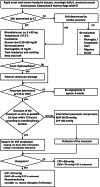Aneurysmatic subarachnoid haemorrhage
- PMID: 33324881
- PMCID: PMC7650083
- DOI: 10.1186/s42466-019-0015-3
Aneurysmatic subarachnoid haemorrhage
Abstract
Introduction: Aneurysmatic Subarachnoid Haemorrhage (aSAH) is typically caused by extravasated blood in the subarachnoid space due to a ruptured aneurysm. aSAH is often life-threatening in the acute stage, but may also cause secondary brain damage due to delayed cerebral ischaemia (DCI) and other complications in the days and weeks after the initial bleeding. Rapid onset of a most severe headache is a typical sign of a non-traumatic aSAH besides a reduced level of consciousness and neurologic deficits.
First steps: Immediate diagnostic steps in case of a suspected SAH are cerebral imaging (CCT, MRI) and lumbar puncture. If a SAH is confirmed, a digital subtraction angiography should be performed to detect an aneurysm. If an aneurysm is detected it should be occluded immediately after interdisciplinary consultation with neurosurgeons and neuroradiologists.
Comments: If endovascular coiling and surgical clipping are both available and equally suitable, coiling should be preferred due to a better long-time outcome. Often the age of the patient, the location of the aneurysm, and the configuration of the aneurysm result in favouring one or the other technique. Special care aims at avoiding stress, increased intracranial pressure, pain, fever, emesis, and at keeping glucose levels and electrolytes in the normal range. As nimodipine is associated with a better outcome, it should be administered from the beginning. To detect vasospasm, serial transcranial doppler should be performed at least once a day for at least 14 days. If vasospasms are detected, this procedure needs to be continued until flow velocity returns to the normal range. To detect an increased intracranial pressure, external ventricular drainage or intraparenchymal probes are recommended. Regarding haemodynamics, euvolaemia and normotension should be achieved. If vasospasms and/or an increased intracranial pressure occur, mean arterial pressure needs to be adjusted to ensure an adequate cerebral perfusion pressure.
Conclusions: If immediate actions are taken to treat the aneurysm and complications in the following weeks are handled with care, a favourable outcome is possible for this otherwise often devastating disease.
Keywords: Clipping; Coiling; Delayed cerebral ischaemia; Nimodipine; Standard operating procedure; Vasospasm.
© The Author(s) 2019.
Conflict of interest statement
Competing interestsThe authors declare that they have no competing interests.
Figures
References
-
- Diringer MN, Bleck TP, Hemphill JC, Menon D, Shutter L, Vespa P, Zipfel G. Critical Care Management of Patients Following Aneurysmal Subarachnoid Hemorrhage: Recommendations from the Neurocritical Care Society’s Multidisciplinary Consensus Conference. Neurocritical Care. 2011;15(2):211–240. doi: 10.1007/s12028-011-9605-9. - DOI - PubMed
-
- Mees, S. D., Rinkel, G. J., Feigin, V. L., Algra, A., Bergh, W. M., Vermeulen, M., & Gijn, J. V. (2007). Calcium antagonists for aneurysmal subarachnoid haemorrhage. Cochrane Database of Systematic Reviews. 10.1002/14651858.cd000277.pub3. - PubMed
LinkOut - more resources
Full Text Sources
Research Materials

